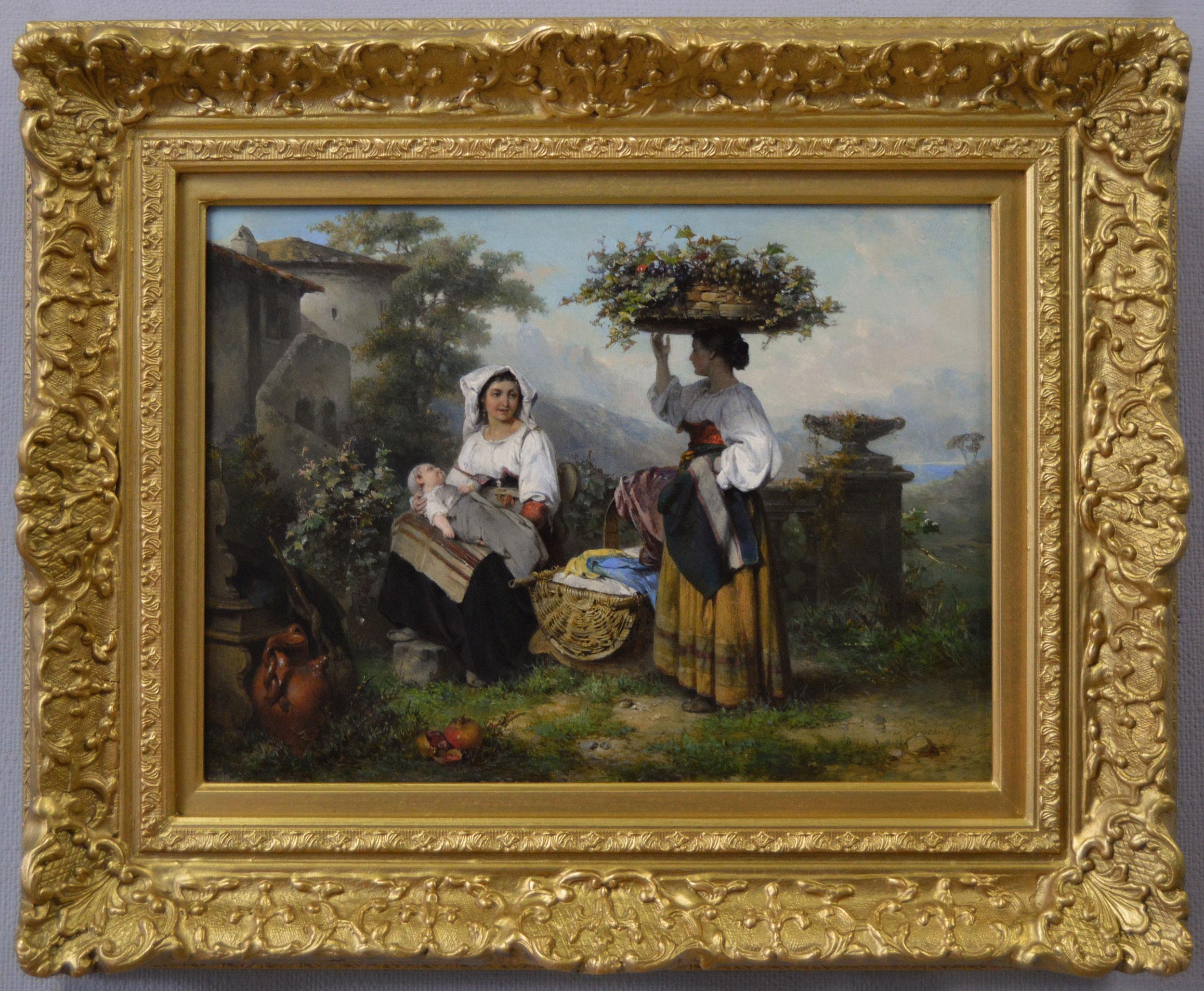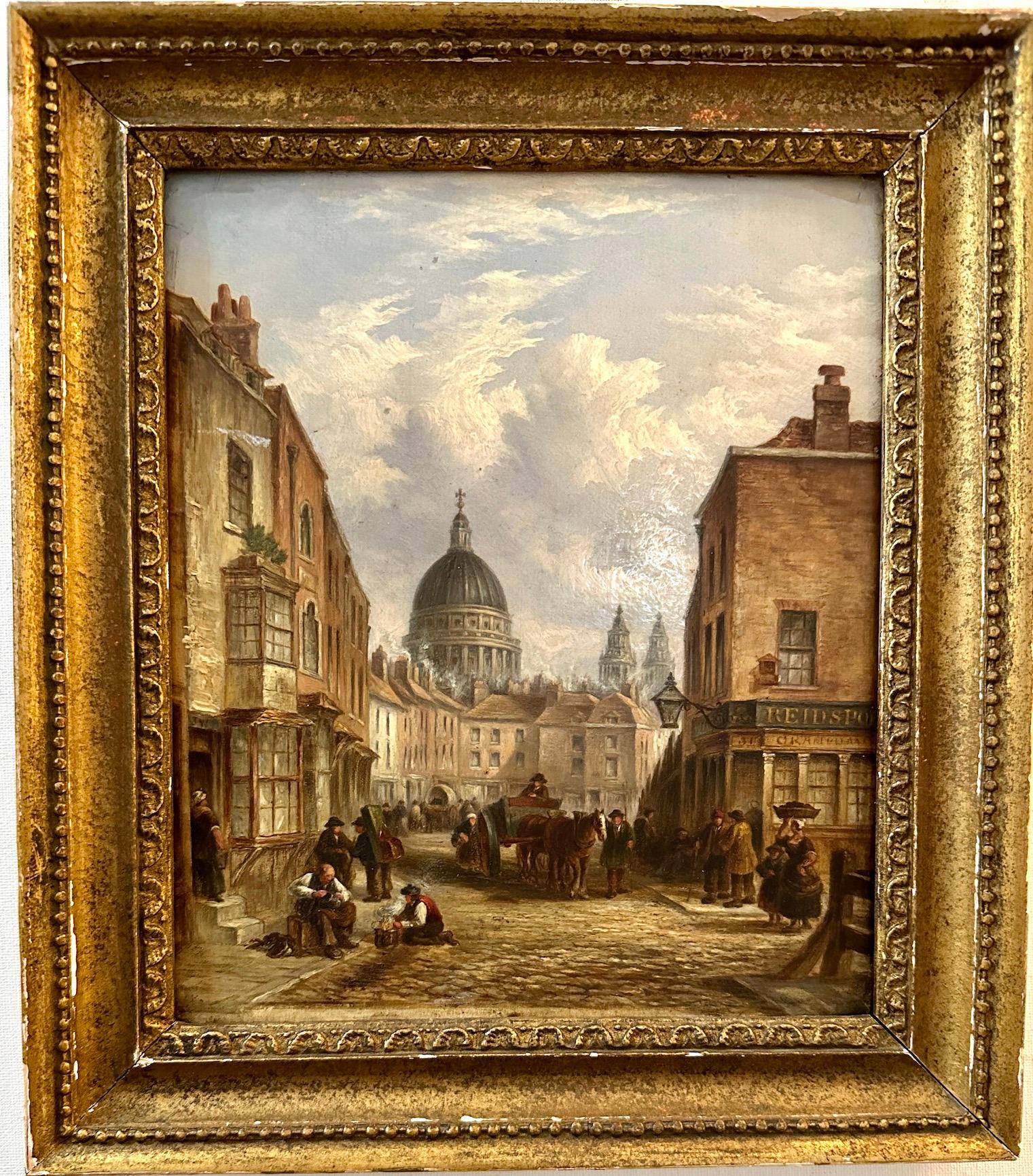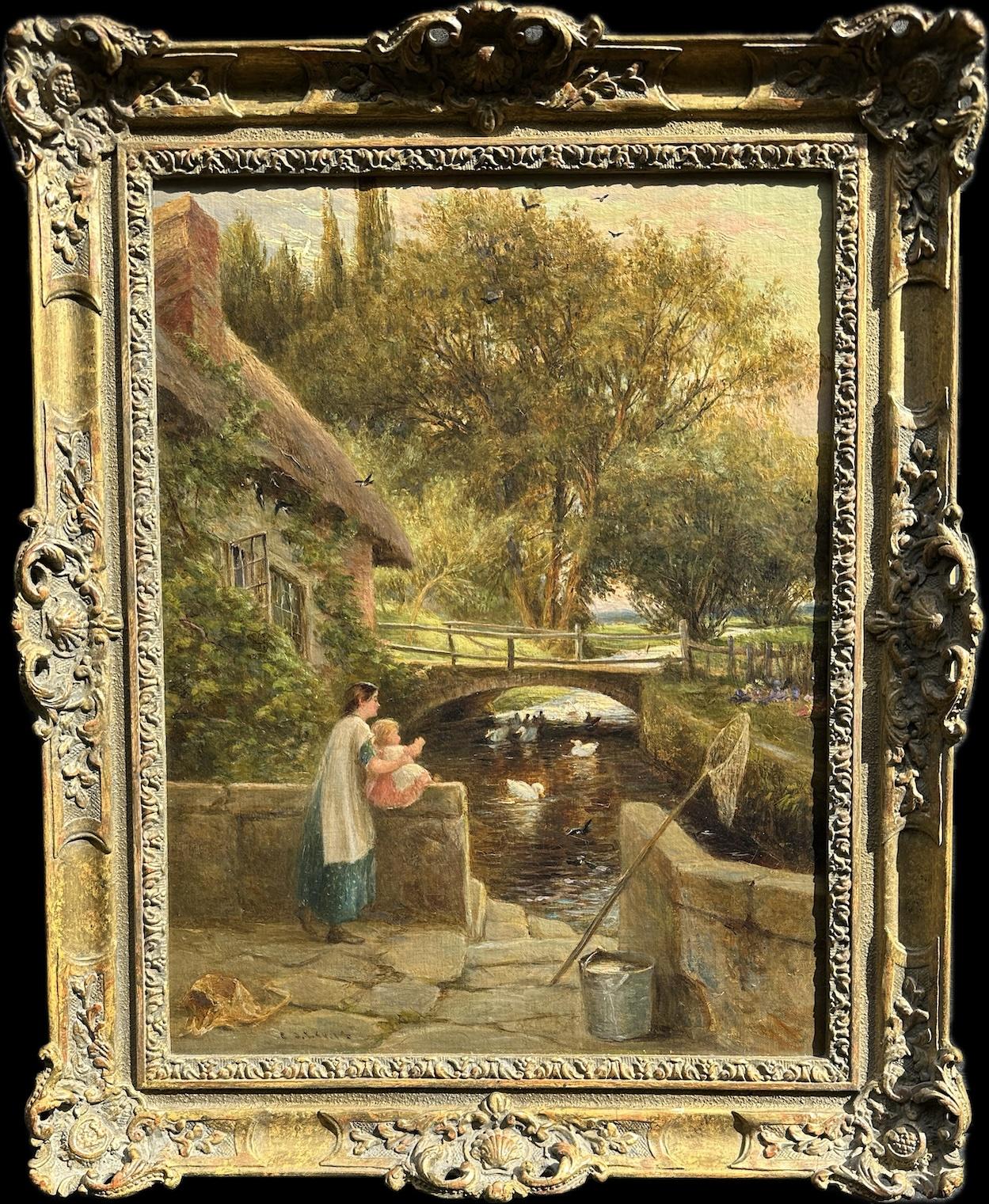Items Similar to Study for Eastward Ho!, Oil on Panel 19th Century Painting
Want more images or videos?
Request additional images or videos from the seller
1 of 7
Henry Nelson O'NeilStudy for Eastward Ho!, Oil on Panel 19th Century Painting
About the Item
Oil on panel
Image size: 20 x 16 inches (51 x 40.5 cm)
Handmade gilt frame
Provenance
Family estate
This preliminary oil sketch for one of O'Neil's most famous works, "Eastward Ho!", was first exhibited at the Royal Academy in 1858. The full-scale painting depicts soldiers on board a ship at Gravesend, destined for service in India during the Indian Mutiny, bidding farewells to loved ones. The work changed the artist's career and became one of the most popular images in Victorian art. Following its first public appearance at the Royal Academy in 1858, a tour of Britain was organised for the picture, during which time an estimated 540,000 people came to see it. O'Neil made a companion painting, entitled Home Again, depicting the return of the same troops, which was exhibited at the Royal Academy in the following year.
In 1860 the two paintings were exhibited side by side in Piccadilly, London where viewers had to pay six pence to view the two works.
The present work shows the artist working on details of the composition, which were significantly altered in the finished version. For example, the direction of the composition is in reverse, and the female figure in the foreground is shown with her face covered by a handkerchief to hide her anguish, whereas in the final version she is given assistance down the gangplank by an old salt. The motif of the woman with her face buried in a handkerchief is transferred to another figure further up the gangplank.
The painting however was well received with the Illustrated London News describing the work and its popularity as:
“….a national epic. No wonder it is so popular that such crowds assemble around it, scanning every feature of the various actors, till at last they begin to imagine themselves present at, and participators in, the scene…”
The newspaper of the day, The Times, put it:
“….Hope and aspiration are busy among these departing soldiers, and if mothers and wives, and sisters and sweethearts, go down the side sorrowing, it is a sorrow in which there is no despair, and no stain of sin and frailty…..”
It is a poignant scene for despite the bravado and sense of duty of the young men going off to fight their just cause with nothing but a rousing sense of duty, we observe their loved ones who are going to be left behind reluctantly letting their fighting men’s fingers slip from their grasp as they move down the gang plank. For the men we can only see in their faces optimism and patriotism whilst in the faces of the women we see fear and a sense of foreboding.
The Artist
O’Neil was born in Russia to English parents in 1817. He returned to England at the age of six and when he was nineteen years of age studied at the Royal Academy Schools.
In the 1840’s O’Neil was a co-founder of The Clique, which was a group of like-minded young artists, based around the St John’s Wood area of London, who regularly met to peruse each other’s works and offer their own critiques. The coming together of this group was in some ways an act of rebellion against the Royal Academy and in what they saw as its imposition of artistic restrictions. This group wanted to add more realism to their work. They wanted their works to have greater emotional intensity which at the time was frowned upon by the Academy establishment. This group of artists denounced the Pre-Raphaelite Brotherhood and their works and O’Neil was the most vociferous in his opposition to their art. The Clique eventually broke up but Henry O’Neil still believed in its principles and he continued to embrace highly emotional scenes in his works.
O’Neil fared well as an artist and managed to have almost a hundred paintings accepted into exhibitions at the Royal Academy, an establishment, as a member of The Clique, he once criticised. He was made an Associate of the Academy two years after exhibiting these two featured paintings. O’Neil died 1880 aged 63.
- Creator:Henry Nelson O'Neil (1817 - 1880)
- Dimensions:Height: 20 in (50.8 cm)Width: 16 in (40.64 cm)
- More Editions & Sizes:1 of 1Price: $27,287
- Medium:
- Movement & Style:
- Period:
- Condition:
- Gallery Location:London, GB
- Reference Number:1stDibs: LU52412888882
About the Seller
5.0
Vetted Seller
These experienced sellers undergo a comprehensive evaluation by our team of in-house experts.
Established in 2007
1stDibs seller since 2014
64 sales on 1stDibs
Typical response time: 2 hours
- ShippingRetrieving quote...Ships From: London, United Kingdom
- Return PolicyA return for this item may be initiated within 14 days of delivery.
More From This SellerView All
- Ophelia, Victorian 19th Century Royal Academy Oil PaintingLocated in London, GBOil on canvas, signed lower right Image size: 33 1/2 x 56 1/2 inches (85 x 143 cm) Original gilt frame Provenance With the artist's son, Millie Dow Stott Esq., until 1912. Artist's Studio Sale, Christies, November 1913. Private Collection Exhibitions London, Royal Academy, 1895, no. 679. Paris, Societe de la Nationale des Beaux-Arts, 1896, no. 1179. Berlin, VII Internationale Kunstausstellung 1897. no. 3533. Manchester, City of Manchester Art Gallery, 1912, no. 339. In the 1890s William Stott exhibited regularly at the Royal Academy, mainly highly decorative works with subjects derived from classical mythology and literature. This painting was Stott's 1895 entry to the Royal Academy and was subsequently exhibited at the Paris Salon of 1896 and then on to the Berlin, VII Internationale Kunstausstellung 1897. Shakespeare was a favourite source for Victorian painters, and the tragic romance of Ophelia, from Hamlet, was an especially popular subject, featuring regularly in the Royal Academy exhibitions. The most popular and iconic image of Ophelia's death was, and is to this day, John Everett Millais's 1851 painting showing the confused and tragic Ophelia floating downstream on her back in a state of mad ecstasy, arms raised in a gesture of inevitable submission. However, although Stott chose not to pastiche this image, it seems highly likely that he was prompted to take up this subject, which had almost become a 'rite of passage' among Victorian painters, by the fact that in 1894 Millais's Ophelia was presented to the National Gallery of British Art by Sir Henry Tate. It appears that Stott was much influenced by John William Waterhouse...Category
Late 19th Century Victorian Figurative Paintings
MaterialsOil, Canvas
- David with the Head of Goliath, 19th Century Victorian OilBy John Rogers HerbertLocated in London, GBJohn Rogers Herbert RA 1810- 1890 Oil on canvas, dated '1850' lower right on sword strap Image size: 33 ½ x 23 ½ inches Gilt Watts frame This striking painting, depicts David as a y...Category
1850s Victorian Figurative Paintings
MaterialsOil
- Saint Sebastian, 15th Century Religious Oil Painting on PanelLocated in London, GBOil on panel Image size: 16 x 13 1/4 inches (41 x 34 cm) Early gilt frame Saint Sebastian was a Roman centurion who converted to Christianity and, in punishment, the Roman Emperor D...Category
15th Century and Earlier Italian School Figurative Paintings
MaterialsOil, Panel
- The Traveller, European School Oil Painting on panel, Original FrameLocated in London, GBOil on panel Image size: 12 1/2 x 9 1/4 inches (31.75 x 23.5 cm) Original frame This is a captivating portrait of a young woman who we appears to be a traveller. The painting has a ...Category
19th Century Figurative Paintings
MaterialsOil, Wood Panel
- The Annunciation, Gilt Easel Oil Painting, 19th Century European SchoolLocated in London, GBOil on panel Crescent image size, including frame: 11 x 7 3/4 inches (28 x 19.5 cm) Original gilt easel frame This crescent oil piece beautifully depicts the scene of the Annunciati...Category
19th Century Figurative Paintings
MaterialsOil, Panel
- A decorative oval relief with Venus and Cupid, 18th Century Rococo OilBy Jacob De WitLocated in London, GBFollower of Jacob de Wit 1695-1754 Venus and Cupid Oil on panel Image size: 7 ¾ inches x 11 ¾ inches Gilt frame A charming example of trompe-l'œil, this painting is abrim with...Category
18th Century Rococo Figurative Paintings
MaterialsOil, Panel
You May Also Like
- Pair of 19th Century genre oil paintings of childrenLocated in Moreton-In-Marsh, Gloucestershire**PLEASE NOTE: EACH PAINTING INCLUDING THE FRAME MEASURES 20 INCHES X 18 INCHES** Jean Pierre Haag French, (1842-1921) Daily Chores & Little Drummer Boy Oil on panel, pair, both sig...Category
19th Century Victorian Figurative Paintings
MaterialsPanel, Oil
- 19th Century genre landscape oil painting of two Italian women near a vineyardLocated in Moreton-In-Marsh, GloucestershireKarel Frans Philippeau Dutch, (1825-1897) Home from the Vineyard Oil on panel, signed & dated 1867 with old label verso Image size: 11.25 inche...Category
19th Century Victorian Figurative Paintings
MaterialsOil, Panel
- 19th century City view of London from Fleet Street with St.Pauls, shops figuresLocated in Woodbury, CTArcher was born at Newcastle-upon-Tyne, in 1808. In 1820 he went to London, and became a pupil of John Scott, a noted engraver of animals. His apprenticeship was cut short when Scott became ill, and he returned to Newcastle. There, in collaboration with William Collard he etched a series of large plates of Fountains Abbey, after drawings by John Wilson Carmichael, and on his own produced several plates for Mackenzie's History of Durham. He then moved to Edinburgh, where he made a collection of drawings of the ancient buildings and streets of the city. In about 1830 he returned to London, and entered the studio of the engravers William and Edward Finden, who were then working on illustrations for the annuals and such publications as their Bible Illustrations, and The Ports and Harbours of Great Britain. After a few years the market for this kind of illustration declined, and Archer had to find less renumerative work engraving plates for the New Sporting Magazine. Having been elected a member of the New Society of Painters in Water Colours, he produced a series of drawings of St. Mary Overy, previous to its restoration, and of Lambeth Palace. Having accumulated more than one hundred drawings of London...Category
1840s Victorian Landscape Paintings
MaterialsOil, Wood Panel
- Historical genre sporting oil painting of a gentleman hunterLocated in Moreton-In-Marsh, GloucestershireAdolphe Alexandre Lesrel French, (1839-1929) The Sportsman Oil on canvas, signed & dated 1903 Image size: 9.75 inches x 7 inches Size includi...Category
19th Century Victorian Figurative Paintings
MaterialsOil, Panel
- English landscape 19th century Mother and child by a cottage, looking at DucksBy Charles James LewisLocated in Woodbury, CTThis is a wonderful outstanding quality scene of an English cottage garden scene with a mother and Child looking at the Ducks swimming before them. The piece's quality is amazing wi...Category
1860s Victorian Landscape Paintings
MaterialsOil, Panel
- French 19th century, Lady looking at a jewel in an interior, South of FranceLocated in Woodbury, CTAntoine Emile Plassan (1817-1903), a French painter of genre works, portraits and landscapes, was born in Bordeaux. He exhibited frequently at the Salon and was awarded medals in 185...Category
1870s Victorian Figurative Paintings
MaterialsOil, Wood Panel
Recently Viewed
View AllMore Ways To Browse
Antique Picture Frames 16x20
Russian Female Painting
English Paintings 20 Century
Neil Canning
Queen Art
Gumps Paintings
Figure Paintings African American
Salon Trolley
James Conway
How Do U Sell
Tom Nichols
Ulpiano Checa Spanish Painter
Kensington Watch
Leroy Burt
Moroccan Djellaba
Valentino 1994
1957 Chevrolet
Delfts I Holland Plate





